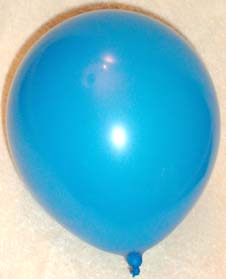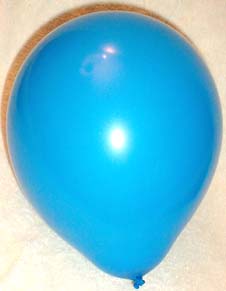Balloon Tips:
Inflation
There
are few things more disappointing than a party decorated with underinflated
balloons. I don't know about you, but when I inflate
balloons, I want to get the most for my dollar. Balloons that are not fully
inflated aren't the right shape or the right color, and never have the shine
that properly inflated balloons do (see Rubber Chemistry 101
for why).
So
no matter your particular interest in balloons, perfect inflation is the most
important tool available to you. First of all, let me offer a quick visual
inflation guide. I'll refer to these levels of inflation as I continue.

This balloon is clearly underinflated. Note the round
shape and long uninflated neck. It's also not very shiny. Not useless
though: games that require sitting or stomping on balloons to pop are made
more interesting by underinflated balloons. |

This is a fully-inflated balloon--not underinflated,
not overinflated. The right size for most games and decorations. This is a
fairly vague category, but you'll know when you're there. |

For those who enjoy an occasional thrill, balloons can
be overinflated like this one. Note how shiny this balloon has become and
how long the neck is. New balloons inflated to this stage (if they make it
this far) are sometimes unpredictable and can spontaneously pop. |
Inflation
falls into several stages-- which can be described as distinct regions on the
balloon's stress-strain curve (see Balloon Physics 101):
stretching, constant-volume blowing, constant-pressure blowing, neck inflation,
and overinflation. The description I'll give relates mainly to round balloons--
airships and other shapes are not that different, but they (usually) lack an
appreciable neck to speak of.
- Stretching. A new balloon should be
stretched several times before attempting to inflate it for the first time.
Stretch the balloon once lengthwise and once crosswise-- just grasp it
between your fingers and thumbs and give it a good tug or two. Finally,
stretch the neck of the balloon a couple times.
- Constant-volume blowing. Put the lip
of the balloon between your own lips (between your teeth if you need) and
blow. The breath should originate from the lungs and have the force of your
diaphragm behind it. Don't puff out your cheeks, keep them tight.
This inflation stage involves blowing up the balloon to a point where the
uninflated balloon snaps "to attention" but does not begin to
stretch yet. For round balloons, the transition from this stage to the next
is very easy. However, balloons like 260s are
notoriously difficult to inflate at this stage.
- Constant-pressure blowing. Once
adequate pressure builds up in the unstretched balloon, it begins to stretch
and expands at a constant pressure as you blow more air into the balloon. As
you blow, keep an eye on the drip point (the thick portion opposite the
neck) and keep a hand on the balloon's side to gauge how tightly stretched
it's becoming. And if you're inflating a large balloon, be careful not to
pass out! Continue blowing until the balloon tightens underneath your hand,
or until the drip point becomes small enough. Also, watch the neck of the
balloon-- when the neck first begins to inflate, you'll be able to tell.
Move on to the next step when this happens.
At this point, you may stop and tie your balloon--
this is the full-inflation stage, defined as the point at which the
balloon's neck first inflates. To take the balloon to overinflation, the
rest of the neck must be inflated. Caution: overinflating a balloon can
be an unpredictable process. For your protection, it is advisable to wear
protective eyewear. A pair of sunglasses or goggles will work.
-
| Neck inflation.
First, stretch the balloon's neck a few times. It works best if,
rather than pinching the neck with both hands, one hand tugs the
rolled lip while the other lightly squeezes the inflated portion of
the neck (pictured at right-- click for a video demo). After
stretching the balloon's neck several times, slowly blow more air into
the balloon. The neck will inflate toward your lips. With your free
hand, continue to test the tightness of the balloon's body as you
inflate. |
 |
If at any point the balloon becomes
significantly more difficult to inflate, stop and tie the balloon off--
it is as inflated as it is going to be. If you still want a bigger, tighter
balloon (or if you're taking this balloon "all the way" so to
speak), continue with extreme caution. Otherwise, tie
the balloon off and put it to use.
- Overinflation. The balloon
will now be much more difficult to inflate, especially so with larger
balloons (24" and larger are the most difficult). Often, the neck is
inflated so completely that holding the balloon between your lips will be
next to impossible. This is the point of the stress-strain curve at which
the balloon does not expand any further but gets tighter (constant-volume
and increasing pressure-- the vertical area of the stress-strain curve). A
balloon inflated this far can pop at any moment, so if you decide to blow
any more air into the balloon, do so with caution.
This guide
works well as a walkthrough, but remember that each balloon is different-- some
balloons are thin enough that their
tightness is never established; some contain synthetic rubber making them harder
and tighter sooner than balloons made with 100% natural latex. The best way to
figure out how a balloon will behave is to just inflate one as a trial and see
what develops.
As far as
balloons popping during inflation, it is a very rare occurrence, especially with
higher-quality brands. At one extreme, there are brands that are of sufficiently
high quality to have only one defective balloon per gross, or less; at the
other, there was once a bag of airship-shaped balloons I bought in which none of
the balloons inflated past halfway without popping. They were drug-store
balloons however; if you stick to major, reputable brands, you'll not have to
worry too much.
Uses for Certain Balloon Inflations
 |
Don't
ever let me catch you decorating with underinflated balloons, heh heh heh...
but they can be of use. In any balloon game requiring sitting, stomping,
or otherwise crushing balloons until they pop, underinflated balloons can
make the game much more challenging. Due to their large uninflated neck,
they can take a lot of abuse and simply transfer any displaced air into
the neck, making them very hard to sit-pop or stomp-pop. For any other
purpose, however, do yourself a favor and inflate at least to the full
size. |
 |
Fully-inflated
balloons are truly multipurpose. They're just the right size or shape to
decorate with, play with, or pop by whatever means you wish (quality
balloons can take quite a lot of abuse, even at full inflation-- you'd be
surprised). Especially for decoration, make sure your balloons are at
least this full-- it brings out the color and shine of the balloon just as
the manufacturer intended. |
 |
Balloons
that have been "necked-up" or overinflated are great fun to have
around. Try using them in any balloon game in which popping balloons is
undesirable-- these balloons make it hard not to pop them if subjected to
rough handling. Because of their mirror-like shine, feel free to use
overinflated balloons to decorate-- just be sure the room doesn't get too
hot, because often these balloons are just looking for an excuse to pop
when you least expect. And if you ever do a small balloon drop at a party,
or any other decorating that involves loose balloons laying around the
floor, try overinflating them. These balloons are likely to be popped
during the party anyway, so might as well have them as big as they can be
before they do! |